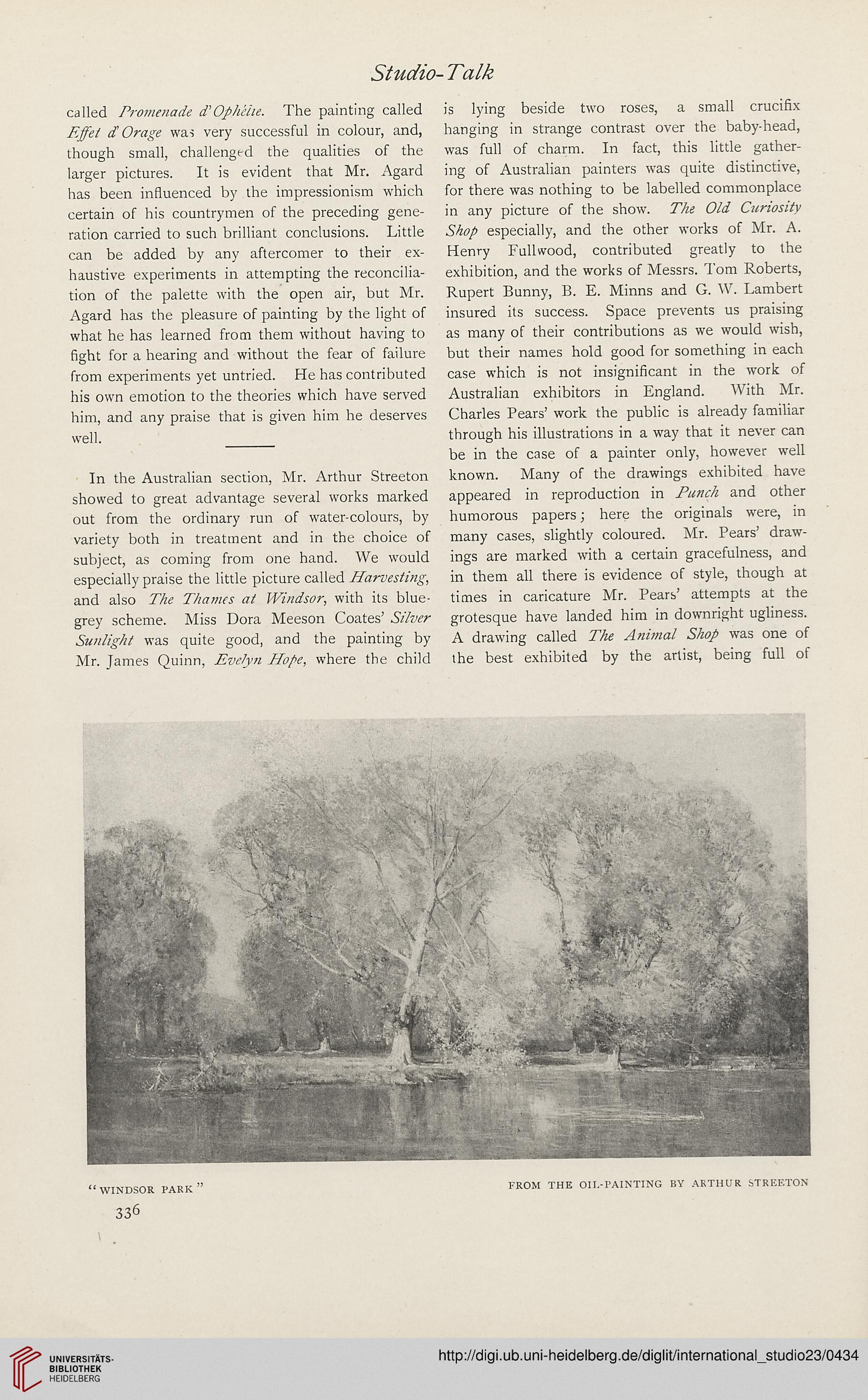Studio-Talk
called Promenade d'Ofiheiie. The painting called
Effet d' Orage was very successful in colour, and,
though small, challenged the qualities of the
larger pictures. It is evident that Mr. Agard
has been influenced by the impressionism which
certain of his countrymen of the preceding gene-
ration carried to such brilliant conclusions. Little
can be added by any aftercomer to their ex-
haustive experiments in attempting the reconcilia-
tion of the palette with the open air, but Mr.
Agard has the pleasure of painting by the light of
what he has learned from them without having to
fight for a hearing and without the fear of failure
from experiments yet untried. He has contributed
his own emotion to the theories which have served
him, and any praise that is given him he deserves
well.
In the Australian section, Mr. Arthur Streeton
showed to great advantage several works marked
out from the ordinary run of water-colours, by
variety both in treatment and in the choice of
subject, as coming from one hand. We would
especially praise the little picture called Harvesting,
and also The Thames at Windsor, with its blue-
grey scheme. Miss Dora Meeson Coates’ Silver
Sunlight was quite good, and the painting by
Mr. James Quinn, Evelyti Hope, where the child
is lying beside two roses, a small crucifix
hanging in strange contrast over the baby-head,
was full of charm. In fact, this little gather-
ing of Australian painters was quite distinctive,
for there was nothing to be labelled commonplace
in any picture of the show. The Old Curiosity
Shop especially, and the other works of Mr. A.
Henry Fullwood, contributed greatly to the
exhibition, and the works of Messrs. Tom Roberts,
Rupert Bunny, B. E. Minns and G. W. Lambert
insured its success. Space prevents us praising
as many of their contributions as we would wish,
but their names hold good for something in each
case which is not insignificant in the work of
Australian exhibitors in England. With Mr.
Charles Pears’ work the public is already familiar
through his illustrations in a way that it never can
be in the case of a painter only, however well
known. Many of the drawings exhibited have
appeared in reproduction in Punch and other
humorous papers; here the originals were, in
many cases, slightly coloured. Mr. Pears’ draw-
ings are marked with a certain gracefulness, and
in them all there is evidence of style, though at
times in caricature Mr. Pears’ attempts at the
grotesque have landed him in downright ugliness.
A drawing called The Animal Shop was one of
the best exhibited by the artist, being full of
called Promenade d'Ofiheiie. The painting called
Effet d' Orage was very successful in colour, and,
though small, challenged the qualities of the
larger pictures. It is evident that Mr. Agard
has been influenced by the impressionism which
certain of his countrymen of the preceding gene-
ration carried to such brilliant conclusions. Little
can be added by any aftercomer to their ex-
haustive experiments in attempting the reconcilia-
tion of the palette with the open air, but Mr.
Agard has the pleasure of painting by the light of
what he has learned from them without having to
fight for a hearing and without the fear of failure
from experiments yet untried. He has contributed
his own emotion to the theories which have served
him, and any praise that is given him he deserves
well.
In the Australian section, Mr. Arthur Streeton
showed to great advantage several works marked
out from the ordinary run of water-colours, by
variety both in treatment and in the choice of
subject, as coming from one hand. We would
especially praise the little picture called Harvesting,
and also The Thames at Windsor, with its blue-
grey scheme. Miss Dora Meeson Coates’ Silver
Sunlight was quite good, and the painting by
Mr. James Quinn, Evelyti Hope, where the child
is lying beside two roses, a small crucifix
hanging in strange contrast over the baby-head,
was full of charm. In fact, this little gather-
ing of Australian painters was quite distinctive,
for there was nothing to be labelled commonplace
in any picture of the show. The Old Curiosity
Shop especially, and the other works of Mr. A.
Henry Fullwood, contributed greatly to the
exhibition, and the works of Messrs. Tom Roberts,
Rupert Bunny, B. E. Minns and G. W. Lambert
insured its success. Space prevents us praising
as many of their contributions as we would wish,
but their names hold good for something in each
case which is not insignificant in the work of
Australian exhibitors in England. With Mr.
Charles Pears’ work the public is already familiar
through his illustrations in a way that it never can
be in the case of a painter only, however well
known. Many of the drawings exhibited have
appeared in reproduction in Punch and other
humorous papers; here the originals were, in
many cases, slightly coloured. Mr. Pears’ draw-
ings are marked with a certain gracefulness, and
in them all there is evidence of style, though at
times in caricature Mr. Pears’ attempts at the
grotesque have landed him in downright ugliness.
A drawing called The Animal Shop was one of
the best exhibited by the artist, being full of




